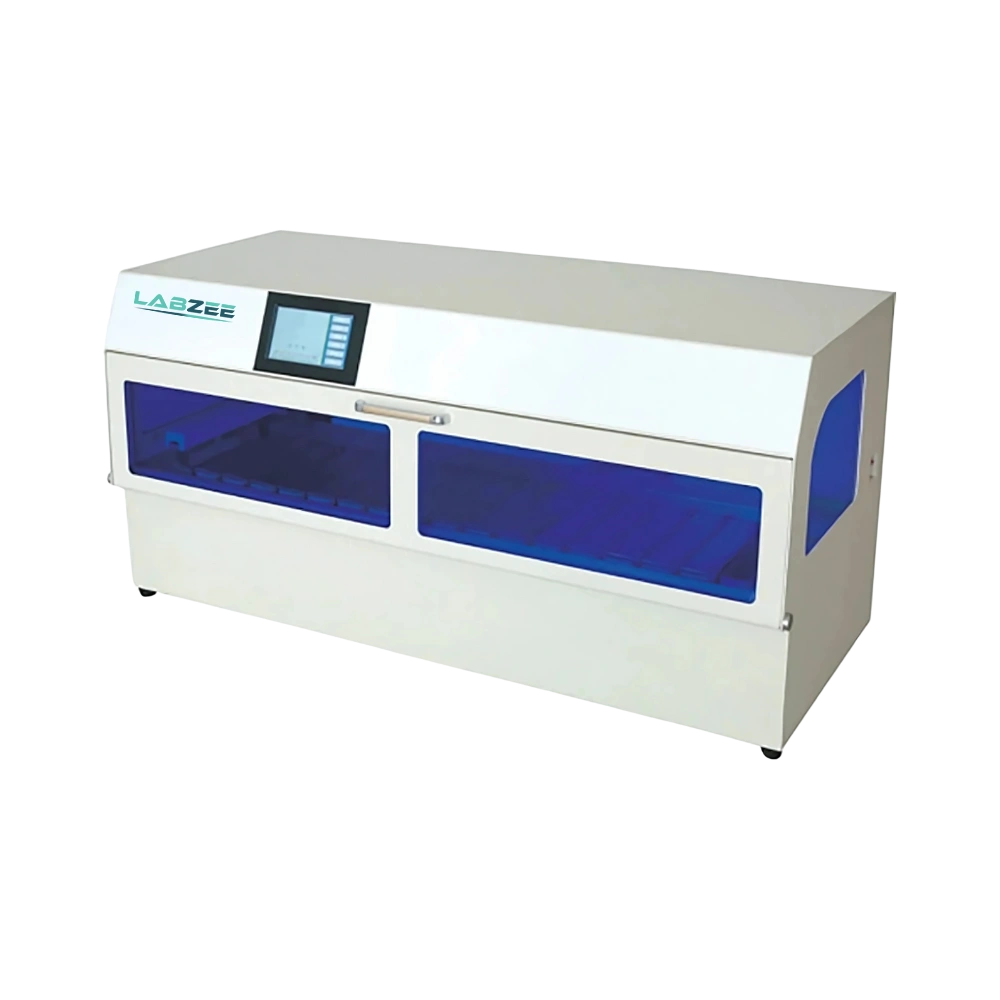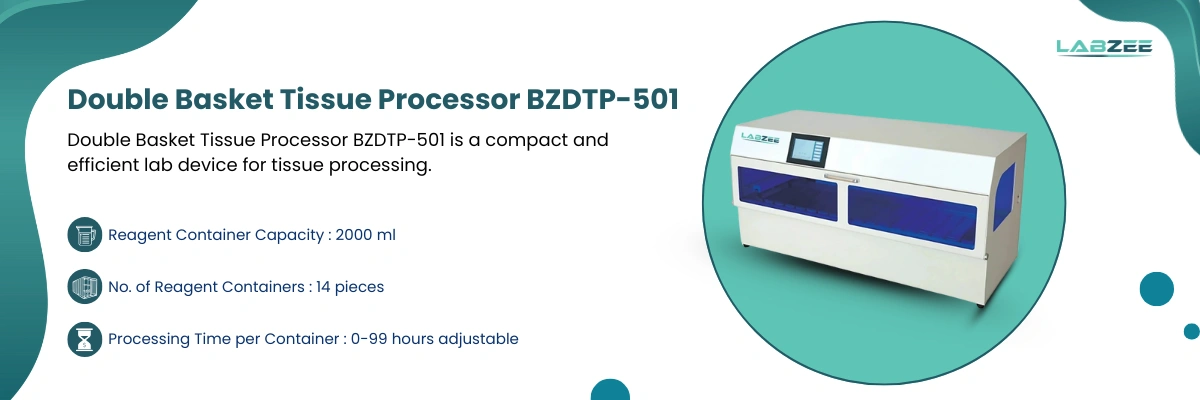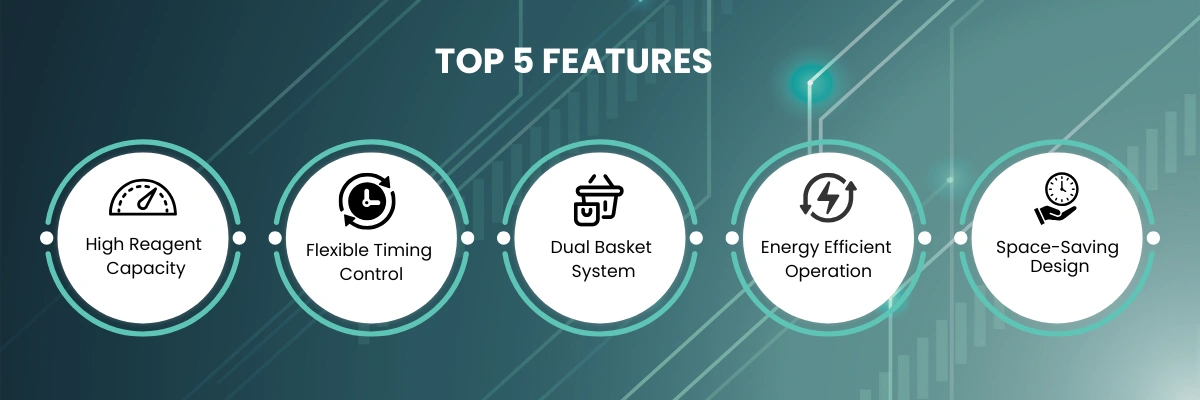
Double Basket Tissue Processor BZDTP-501 is a compact and efficient lab device for tissue processing. This Tissue Processor features a reagent container capacity of 2000 ml, 14 reagent containers, and an adjustable processing time per container from 0 to 99 hours. It provides flexible processing cycles with customizable timing to suit different tissue types. Its dual-basket design allows handling of approximately 200 tissue samples in one batch, improving lab throughput. Our Double Basket Tissue Processor BZDTP-501 is ideal for histology labs, pathology centers, clinical diagnostics, and research facilities.
$8,811.00
| Reagent Container Capacity | 2000 ml |
| No. of Reagent Containers | 14 pieces |
| Processing Time per Container | 0-99 hours adjustable |
| No. of Dehydrated Tissues | About 200 pcs (100 pcs per basket) |
| Hanging Basket Filtrate | Time can be adjusted arbitrarily |
| Power Consumption | 500 W |
| Power Supply | AC 220V ±10%, 50 Hz |
| Product Dimension | 1300 × 600 × 600 mm |
| Package Dimension | 1380 × 680 × 740 mm |
| Net Weight | 116 Kg |
| Gross Weight | 173 Kg |
| Packaging Type | Wooden Case |
Our Double Basket Tissue Processor supports laboratories by automating tissue sample dehydration and processing, making it perfect for embedding, histopathology sample prep, diagnostic testing, and research. This Processor enhances accuracy and consistency, helping labs increase productivity while maintaining high-quality results.
Frequently Asked Questions
1: What is the reagent container capacity of the Double Basket Tissue Processor BZDTP-501?
The Double Basket Tissue Processor BZDTP-501 features reagent containers each with a capacity of 2000 ml. This large volume supports extended processing cycles and reduces the need for frequent reagent replacement, enhancing overall efficiency in the laboratory.
2: How many reagent containers can the Double Basket Tissue Processor BZDTP-501 hold, and why is this important?
It accommodates 14 reagent containers, which allows laboratories to run complex tissue processing protocols using multiple reagents in one automated cycle, improving workflow versatility and saving time.
3: Is it possible to adjust the processing time on the Double Basket Tissue Processor BZDTP-501? If so, what is the time range?
Yes, the processing time on the Double Basket Tissue Processor BZDTP-501 is fully adjustable from 0 to 99 hours per container. This feature offers laboratories the flexibility to tailor the tissue processing according to the sample requirements.
4: How many tissue samples can the Double Basket
Tissue Processor BZDTP-501 process simultaneously? This device is capable of processing about 200 dehydrated tissue samples at once, divided equally between its two baskets, which significantly increases sample throughput and lab productivity.
5: What electrical specifications and physical size does the Double Basket Tissue Processor BZDTP-501 have?
The Double Basket Tissue Processor BZDTP-501 operates on an AC 220V ±10% power supply with 50 Hz frequency. Its compact dimensions allow it to fit comfortably within most laboratory spaces while maintaining a sturdy construction for reliable operation.
6: When should a Double Basket Tissue Processor be used?
A Double Basket processor is ideal when large sample volumes need processing in limited time. It allows parallel processing of different batches or protocols. This improves efficiency in high-demand labs.
7: Can two different protocols be run simultaneously?
Yes, many Double Basket models allow independent programming for each basket. This helps process different tissue types or urgent samples in parallel. Always check model-specific capabilities for protocol customization.
8: Can the baskets be loaded while the unit is running?
No, for safety and to maintain protocol integrity, baskets should only be loaded when idle. Opening during operation may interrupt cycles or expose reagents. Always wait for completion and follow proper procedures.
9: When is cleaning or maintenance required?
Routine cleaning is recommended after each full cycle or daily use. Scheduled maintenance depends on usage frequency and reagent type. Proper upkeep ensures consistent results and longer system life.
10: Can it be used for overnight processing?
Yes, these processors are often designed for overnight runs with automated control. Safety systems monitor temperature and reagent levels during unattended use. Ensure all parameters are correctly set before initiating long cycles.

